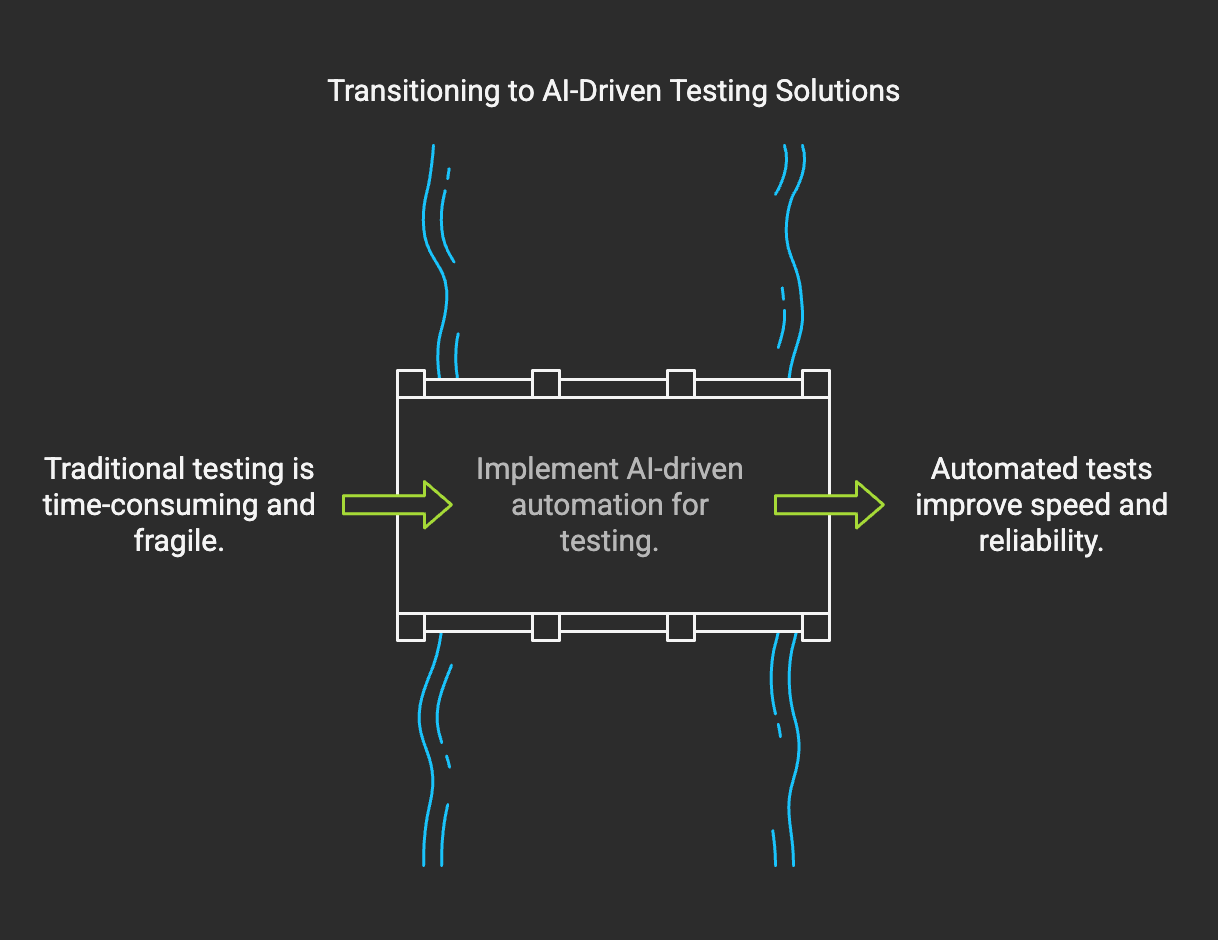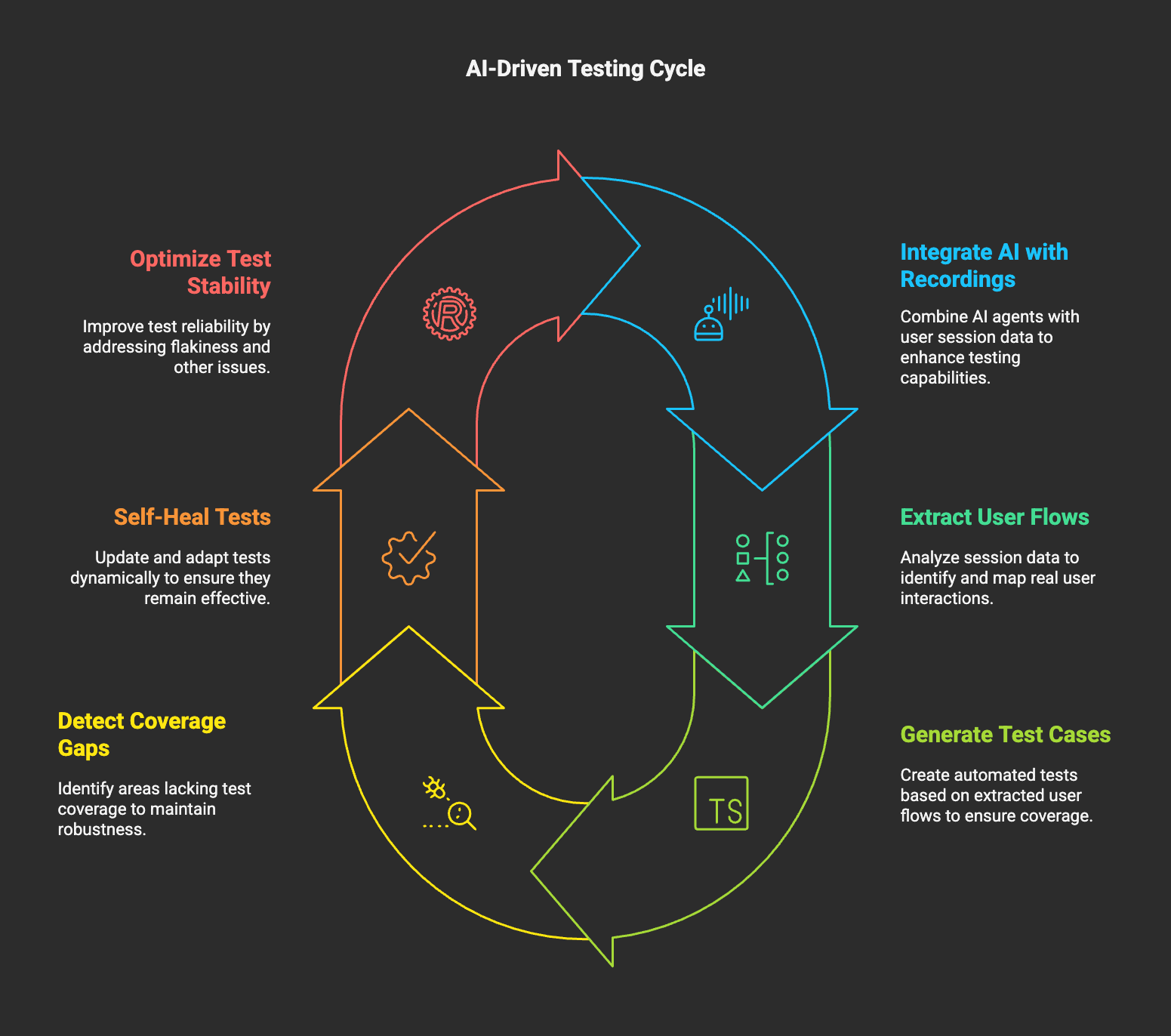Software testing has always been a tough nut to crack. Traditional end-to-end (E2E) testing is essential, but let's be honest, it's a hassle. It takes time, it's fragile, and maintaining tests can feel like an endless chore.
But what if testing could be smarter? What if tests could write themselves based on how real users interact with your product? That's exactly what AI-driven automation is bringing to the table.

Companies like Posium are changing the game by leveraging user session recordings to automate test generation, improve coverage, and reduce the headache of test maintenance. Instead of manually scripting every test case, AI-driven agents can now observe user interactions and create adaptive, self-healing tests - bringing software testing into the future.
This blog explores how session recordings power AI-driven E2E testing, how agentic testing platforms are reshaping test automation, and the benefits this approach brings to QA engineers, test automation specialists, and developers.
What is User Session Recording?
User session recording captures real user interactions with a web or mobile application. These recordings track events like clicks, scrolls, form inputs, network requests, and DOM changes. Unlike traditional analytics tools, session replays provide a visual representation of how users experience a product.
How Session Recording Works
Open-source libraries like rrweb record user sessions by capturing:
- DOM snapshots: Initial page structure
- Incremental DOM mutations: Changes as users interact
- User events: Clicks, keystrokes, scrolls, etc.
- Network activity: API calls and responses
- Console logs & errors: Debugging insights
These data points are compressed, transmitted to a storage backend, and later replayed to reconstruct the user session.
Popular Session Recording SaaS Products
Many SaaS platforms offer session recording, including:
- PostHog – Open-source product analytics with session replays
- FullStory – AI-driven session insights
- LogRocket – Developer-friendly debugging tool
While these tools focus on user experience and debugging, Posium takes it a step further by using session recordings to automate E2E testing.
What is End-to-End Software Testing?
End-to-end software testing validates entire workflows in an application, ensuring frontend, backend, APIs, and databases work together. Unlike unit or integration tests, E2E tests simulate real-world user scenarios, making them crucial for ensuring software reliability.
Why E2E Testing Matters More in the AI Era
AI-driven applications (e.g., recommendation engines, chatbots) introduce non-deterministic behaviors, making them harder to test with static scripts. Agentic testing approaches powered by Gen AI for testing help by dynamically adapting to application changes, ensuring robust validation.
Common E2E testing frameworks include:
- Selenium – Web automation for multiple browsers
- Cypress – Modern UI test automation
- Playwright – Cross-browser web testing with parallel execution
- Appium – End-to-end mobile testing for iOS & Android
While these frameworks are powerful, they require manual script creation and maintenance. This is where AI-powered agentic testing platforms offer a revolutionary alternative.
The Rise of Agentic Testing Platforms
What is Agentic Testing?
Agentic testing refers to AI-driven test automation where autonomous agents analyze an application, generate test scenarios, and execute them without human intervention. Unlike traditional scripted automation, these agents learn from real user behavior, making them highly adaptive.
How AI Agents for Testing Leverage Session Recording

Companies like Posium integrate AI-driven agents with user session recordings to:
- Extract real user flows and generate automated test cases
- Detect missing test coverage and expand the test suite
- Self-heal tests by dynamically updating selectors and waits
- Identify flakiness and optimize test stability
For example, if many users experience an issue during checkout, AI can proactively add test cases to ensure robustness in future deployments.
Generating Tests from User Sessions
With AI, session recordings can be transformed into code-based tests in frameworks like Playwright, Cypress, Selenium, and Appium. This enables fully automated end-to-end mobile testing and web testing without requiring access to source code.
Self-Healing Test Automation
A major challenge in E2E testing is flaky tests, often caused by:
- Dynamic UI elements (e.g., changing CSS selectors)
- Timing issues (e.g., elements loading asynchronously)
- Environment differences (e.g., inconsistent network responses)
AI-driven test agents solve this by auto-correcting selectors, inserting dynamic waits, and adapting to UI changes. This significantly reduces flakiness, ensuring more stable test executions.
These self-healing tests directly address one of the top challenges faced by test automation engineers, especially when dealing with frequently changing UIs.
Advantages of AI-Driven Test Generation from Session Recordings
1. Higher Test Coverage Without Manual Effort
Traditional test creation relies heavily on manual effort, which can lead to gaps in coverage, especially in complex user flows. AI-driven test generation captures real-world user journeys directly from session recordings, ensuring that test cases reflect actual usage patterns. It also detects untested paths that manual QA processes might overlook, improving test completeness without increasing workload.
2. Reduced Test Flakiness
One of the biggest challenges in test automation is flakiness—tests failing due to minor UI changes rather than actual issues. AI-driven testing minimizes this by dynamically adjusting to UI updates, reducing false positives and unnecessary debugging. With self-healing capabilities, tests automatically adapt to small UI changes, ensuring consistent reliability without requiring constant maintenance.
3. No Need for Access to Source Code
AI-powered testing operates solely on session data, making it a perfect solution for scenarios where direct access to source code isn't possible—such as testing third-party applications. This also makes test automation more accessible to non-technical teams by enabling low-code and no-code approaches, reducing dependency on engineers for test creation and execution.
4. Significant Time Savings for QA & Developers
AI-generated test cases are ready in minutes rather than the weeks it typically takes to manually design and implement them. Additionally, since AI continuously adapts tests based on real-time changes, the maintenance burden is drastically reduced. This frees up both QA engineers and developers to focus on higher-value work rather than spending time updating brittle test cases.
5. Proactive Test Suite Expansion
Instead of waiting for test gaps to be discovered after a bug surfaces, AI proactively analyzes user behavior to identify areas of the application that lack sufficient test coverage. It then suggests and automatically generates new test cases for these uncovered flows, ensuring that the test suite evolves alongside the product. This leads to more robust software quality with minimal manual intervention.
Visual Insights: AI vs. Traditional E2E Testing
| Aspect | Traditional E2E Testing | AI-Driven E2E Testing (Agentic) |
|---|---|---|
| Test Creation | Manual scripting required | AI auto-generates from user sessions |
| Maintenance | High (breaks with UI changes) | Low (AI self-heals tests) |
| Coverage | Limited by human anticipation | Learns from actual user interactions |
| Flakiness | Prone to timing issues | AI adjusts waits & selectors dynamically |
| Speed | Slow (manual effort required) | Fast (tests generated in minutes) |
The Future of End-to-End Software Testing
AI-driven agentic testing is redefining software quality assurance. By leveraging user session recording, LLM for testing, and AI Agents for testing, companies can:
- Eliminate test maintenance overhead
- Achieve real-world test coverage effortlessly
- Improve test stability and reduce flakiness
- Automate end-to-end mobile testing and web testing at scale
With Posium's AI-powered testing solutions, teams can shift from reactive, manual test creation to proactive, self-evolving test suites. If you want to move fast without breaking things, it's time to adopt AI-powered end-to-end testing.
When selecting an AI-driven testing solution, be sure to review our guide on how to pick AI-powered testing tools to ensure you choose the right platform for your specific needs.
Sign up today to see how Posium can transform your testing process.
Written by
Naomi Chopra